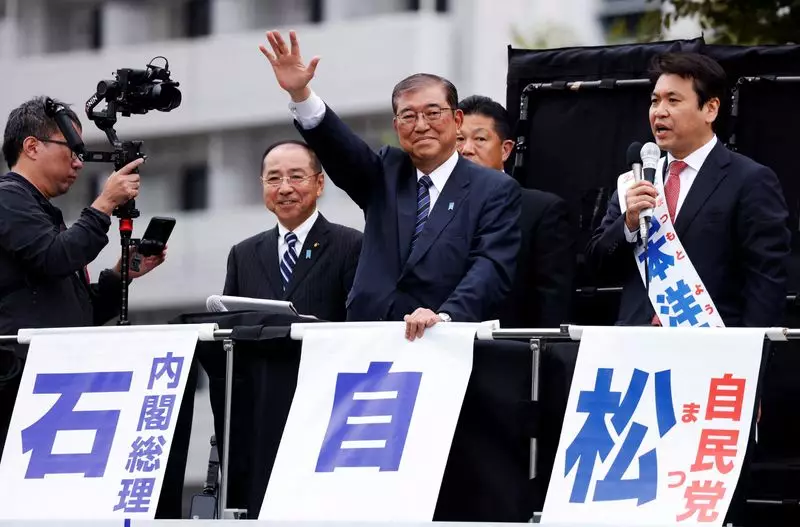The political climate in Japan is once again witnessing an upheaval as the results of the recent general election cast uncertainty on the future governance of the country. With Japanese Prime Minister Shigeru Ishiba’s ruling coalition appearing poised to lose its parliamentary majority, this election marks a pivotal moment for Japanese politics. Various exit polls following the election have underscored significant dissatisfaction among voters, largely driven by a series of political funding scandals and a growing concern over rising prices. The implications of these results not only alter the balance of power but also create a complex landscape for potential coalition negotiations.
The Dominance and Troubles of the LDP
The Liberal Democratic Party (LDP) has maintained a stronghold over Japanese politics for most of the postwar era, but recent events have tarnished this legacy. The LDP’s struggle is evidenced by voter anger related to an ongoing political funding scandal that has marred its reputation. Despite promises to uphold transparency and improve financial ethics, many lawmakers associated with the scandal were allowed to compete in this latest election. This blatant disregard for accountability has left voters disillusioned. Previously holding 247 seats, forecasts predict the LDP may tumble to a range between 153 and 219 seats, sorely lacking the 233 needed to command a majority in the lower house.
Furthermore, jury dissatisfaction is compounded by escalating living costs, particularly in urban areas, heightening the electorate’s critical stance toward the ruling party. Ishiba’s quick call for elections after the resignation of his predecessor, Fumio Kishida, illustrates an acute awareness of escalating disenfranchisement but also a desperate attempt to regain control amid a rapidly shifting political context.
The Komeito Party, allied with the LDP for decades, finds itself at a crossroads. Traditionally a stabilizing force in Japanese politics, it presents an interesting dynamic as ongoing political discourse grows more polarized. Historically affiliated with Sokka Gakkai, Japan’s leading lay-Buddhist organization, Komeito has been instrumental in providing the LDP with a robust volunteer network, especially during campaigning seasons. More than a mere ally, Komeito is often consulted on various policy matters and holds key cabinet positions, including Land Transport and Infrastructure.
However, discontent is likely to grow within its base as the party faces pressure to maintain its pacifist stances while the LDP pushes for military expansion and revised defense policies, leading to an ideological schism that could hamper Komeito’s electoral viability in future contests. Preliminary forecasts suggest Komeito may retain or gain a slight number of seats, potentially winning as many as 35, but internal friction could influence its long-term role in coalition-building.
In contrast, the Constitutional Democratic Party of Japan (CDPJ) has seized the opportunity to position itself as a credible alternative. As the largest opposition entity, it has aggressively campaigned on the back of the LDP’s recent controversies, utilizing a strategy focused on transparency and tackling inflation. Under the leadership of Yoshihiko Noda, the CDPJ aims to unite various discontented constituents dissatisfied with the ruling coalition’s neglect. Early predictions suggest that the CDPJ could double its representation in parliament, consequently placing it at the center of potential coalition negotiations if the current powers cannot secure a majority.
Emerging Contenders: Innovation Party and the Democratic Party for the People
Other notable players include the Japan Innovation Party and the Democratic Party for the People (DPP). The former, led by Nobuyuki Baba, aligns closely with the LDP on security policies and advocates for extensive governmental reforms. As it seeks to reinforce its influence, it juxtaposes itself against traditional politics by promising rigorous checks on political funding and embracing welfare reforms.
Meanwhile, the DPP, which had entered the election with a mere seven seats, might wield considerable power as a potential kingmaker. As a fledgling party advocating for tax cuts and healthcare reforms, its leader, Yuichiro Tamaki, presents an intriguing offer for any coalition unwilling to align with the LDP. If projections hold true, the DPP’s representation could swell to around 33 seats.
Japan’s political environment is undeniably in flux, with the recent election results bringing significant uncertainties to the forefront. The potential erosion of the LDP’s parliamentary dominance highlights the electorate’s desire for change amid discontent over enduring issues. As negotiations begin among various political factions, the speed at which coalitions form—and their subsequent ability to address public concerns—will determine the next chapter in Japan’s political saga. The implications of this election will influence not only domestic policies but also Japan’s international standing, making the stakes exceedingly high for the involved parties.

